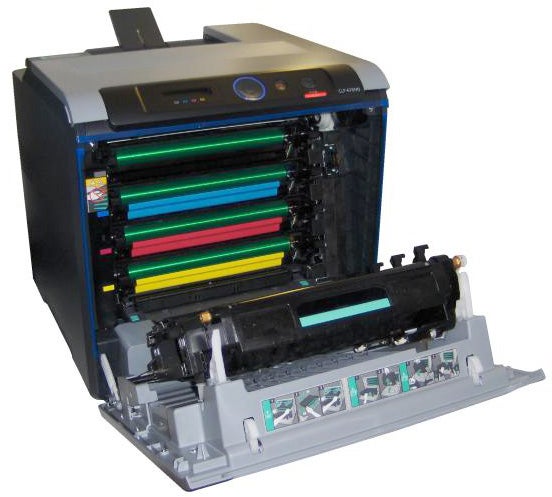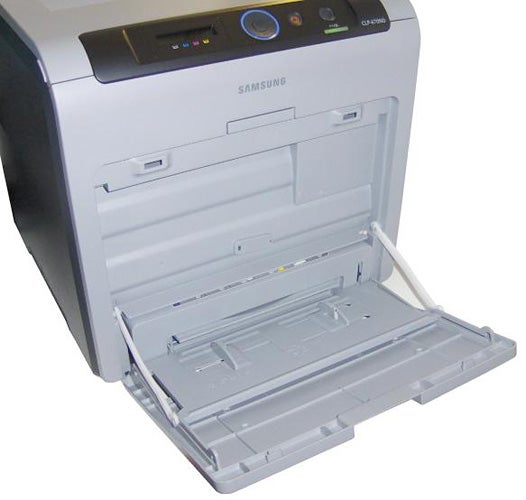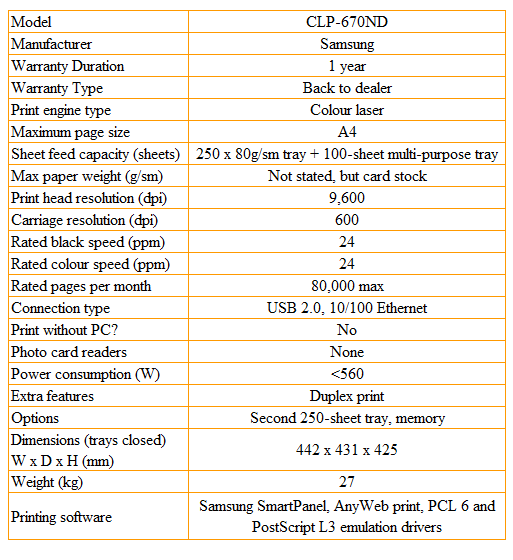Samsung CLP-670ND Review
Samsung CLP-670ND
A mid-range, workgroup colour laser printer with cost-saving duplex print and no real disadvantages.

Verdict
Key Specifications
- Review Price: £430.73
Many people are aware of the advantages of colour laser printing because of low-cost, entry-level machines. One of their functions is as an advertisement for their more expensive siblings higher up the product range, and Samsung’s CLP-670ND is aimed at the medium workgroup of maybe 5-10 office workers.
This is a big block of a machine, with dark grey sides, back and control panel and light grey front and top. Even with its substantial dimensions, you still have to flip out a paper support at the back and printed sheets project by over 100mm. The usual argument for putting data sockets at the side – so a printer can be pushed flush against a wall – doesn’t hold, because of this overhang and the fact that the mains plug slots in at the back.
The control panel is both bold and minimalist, with simple buttons for power and to cancel a job, and a four-way ring for menu navigation with an OK button in the centre and a surrounding blue ring for effect. The 2-line by 16-character LCD display has no backlight, but is still readily readable under normal overhead lighting.
A 250-sheet paper tray slides out from the bottom of the front panel and a further optional tray of the same capacity can be fitted underneath the machine. Additionally, an inset in the front panel folds down to become a 100-sheet multi-purpose tray in a novel arrangement, where the guides on the lid slot into place as it swings down, while a front panel slot flips open to provide access.
The front panel itself folds down to reveal a transfer belt attached to its back and this contacts four combined drum and toner cartridges in the CMYK colours, which are stacked up inside. They slide into place using grips at either end and are very quick and easy to install.
Samsung provides PostScript Level 3 and PCL 6 drivers in emulation, as well as a printer-monitoring applet and a web page print utility. Support is provided on CD for Windows and OS X and various Linux distributions, including Red Hat, Mandrake, SuSE and Fedora, are also supported via download. The CLP-670ND can be connected via USB or 10/100 Ethernet.
Samsung rates the printer at 24ppm in both black and colour print and this isn’t unduly optimistic. Although the five-page black text print returned a fairly slow 9.7ppm and the five-page black text and colour graphics job only lifted this to 12.5ppm, the 20-page black text test returned 18.2ppm – just over two thirds of the claimed speed.
The printer has a duplexer built-in and when we ran the 20-page document as a 10-page duplex test, it completed in 2mins 7secs, giving a speed of 9.5 sides per minute. This is less than spectacular, largely because the paper is nearly fully ejected before being reversed and taken back in to print the second side. Some printer makers have recently developed interleaving techniques for duplex print, which increase the overall speed.
Black text is well formed, as is the case with most modern laser printers, and is perfectly adequate for day-to-day documents. It’s better than the output from any inkjet and easily matches that from most mono laser printers.
This is a printer aimed at business documents, so colour output is geared towards graphics rather than photographs. It does pretty well at this, reproducing bright and vivacious colours ideal for graphs and charts. These are impressively smooth in their application, too, with few signs of patchiness or banding. There’s also very little haloing and black text over colour looks clean and accurately positioned.
Even photographic output is reasonable for a colour laser printer and at the highest resolution, an enhanced 9,600 x 600dpi, the results are better than many. Although some detail is still lost in areas of deep shadow, colour variations are smooth and reasonably natural.
This is a relatively quiet printer for its class and we measured peak noise levels of only 62dBA. This may not seem much lower than the 66-67dBA levels we’ve commented on previously as noisy. Remember, though, that sound levels are measured on a logarithmic scale, so a small numerical difference can mean a big difference in perceived sound.
The cost per page of running this machine is derived from two consumables: the combined drum and toner cartridges and the transfer belt, which has a healthy service life of 50,000 pages. In many environments, only one fresh belt will be needed during the printer’s entire use.
The drum and toner cartridges are available in standard yields of 2,000 pages for colour and 2,500 for black and in high yields of 4,000 pages and 5,000 pages, respectively. Using the high-yield parts for better economy gives costs of 3.1p for black and 11.3p the colour. The black page cost is a little high for a printer costing over £400, though the colour cost is below average.
Verdict
This is a good, robust colour laser printer with cost-saving duplex print as standard, a reasonable turn of speed and above-average print quality. Print costs are in the middle of the field, becoming slightly better when printing colour, and it has the feel of a printer that will just sit there and do its job.


Trusted Score
Score in detail
-
Print Speed 8
-
Features 7
-
Value 7
-
Print Quality 8
Features
| Networking | Fast Ethernet |
Printing
| Duplex | Automatic |
| Paper Size | A4, Letter, 3" x 5", 8.50" x 14", Legal, A6, Custom Size |
| Sheet Capacity | 350 sheets |
| Rated Black Speed (Images per minute) | 25 ppmipm |
| Rated Colour Speed (Images per minute) | 25 ppmipm |

